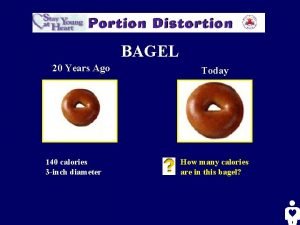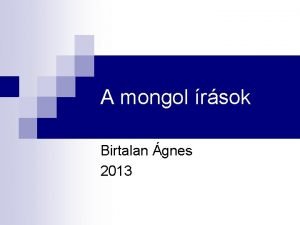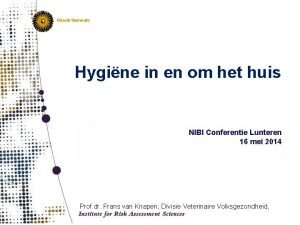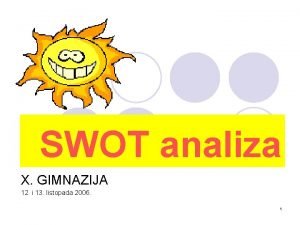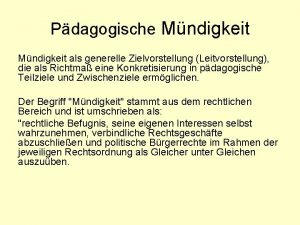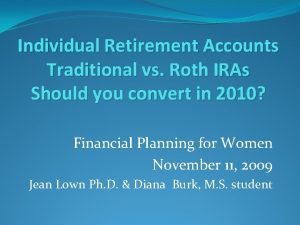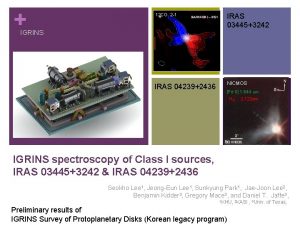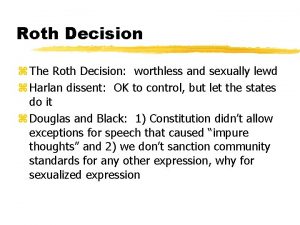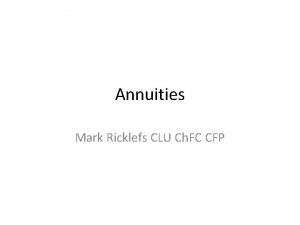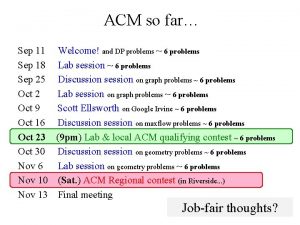Traditional IRAs Roth IRAs and SEP Mark Ricklefs
















- Slides: 16

Traditional IRAs, Roth IRAs, and SEP Mark Ricklefs CLU Ch. FC CFP

Caveat • This presentation is for informational purposes only. The speaker appearing at this meeting is solely responsible for the content of the presentation and may not necessarily represent the opinion of the presenter. The presenter is not in the business of giving tax, legal or accounting advice. Attendees should consult with their own professional advisors to determine the appropriateness of any course of action. Mark Ricklefs is an Investment Advisor Representative offering securities and investment advisory services through Ameritas Investment Corp. (AIC). The opinions and concepts discussed in this presentation are for CE purposes only and are not necessarily those of AIC. The presenter is not in the business of giving tax, legal, or accounting advice. Please consult your personal advisors.

The Purpose of IRAs • Income Earners and some unemployed spouses utilize IRAs to save for retirement on a tax-deferred basis. • Taxes are paid when the IRA owner makes withdrawals. This normally occurs at the age of retirement. • Income earners can either contribute to a traditional IRA or a Roth IRA. • IRA contributions accumulate in a trust or custodial account, with a bank, federally insured credit union, S&L association, or other trustee org. The presenter is not in the business of giving tax, legal, or accounting advice. Please consult your personal advisors.

Allowable Contributions • Limits on annual contributions are the same for traditional and Roth IRAs. These limits vary by age, income, and year of contribution. • Contributions may not exceed 100% of earned income. • An IRA owner can contribute to an IRA for a nonworking or part-time working spouse. • Again, combined contributions cannot exceed combined income for the owner and spouse. • Traditional IRAs require owners to begin taking distributions at 70 ½. The presenter is not in the business of giving tax, legal, or accounting advice. Please consult your personal advisors.

Taxes • Roth IRA contributions are not tax deductible, but traditional IRAs are. • The maximum deduction for traditional IRA contributions corresponds to the maximum allowable contribution. • A traditional IRA carries restrictions on who may take full advantage of the deduction. • The deductible amount is gradually phased out according to adjusted gross income for wage earners who are active participants in another retirement arrangement. • No federal income tax is due when distributions are made, provided certain requirements are met. • Singles with gross incomes of above 125, 000 and joint filers above 183, 00 may not contribute to a Roth IRA. The presenter is not in the business of giving tax, legal, or accounting advice. Please consult your personal advisors.

Distributions • IRA owners may begin taking distributions without tax penalty at age 59 1/2. Earlier distributions are subject to a 10% penalty tax. • Possible exceptions to the 10 percent penalty include distributions made when the owner dies or becomes disables, used to pay for qualified higher education expenses, used to pay for certain qualifying first-time homebuyer expenses, or rolled over within 60 days. • Traditional IRA distributions are taxed as ordinary income in the year they were made. The presenter is not in the business of giving tax, legal, or accounting advice. Please consult your personal advisors.

The Bottom Line • IRAs offer a tax-advantaged way to save for retirement. To choose between a traditional IRA and a Roth IRA involves considerations such as the age, income, and participation in other qualified arrangements of the individual. The presenter is not in the business of giving tax, legal, or accounting advice. Please consult your personal advisors.

Summary of Benefits • Tax-deferred growth for Traditional and Roth IRAs. • Tax-deductibility of contributions to traditional IRAs, subject to limits and restrictions. • No required minimum distributions from a Roth IRA during the owner’s lifetime. • Retirement benefits for workers and spouses. The presenter is not in the business of giving tax, legal, or accounting advice. Please consult your personal advisors.

How a traditional IRA Works 1. The owner establishes a traditional IRA and makes annual contributions. 2. Withdrawals at retirement are taxed as ordinary income in the year received. 3. Contributions are generally tax-deductible for participants who either aren’t covered under an employer-sponsored retirement arrangement or have income falling below specified yearly levels, and contributions and earnings in the IRA grow tax-deferred. The presenter is not in the business of giving tax, legal, or accounting advice. Please consult your personal advisors.

How a Roth IRA works 1. Income earners with adjusted gross incomes below a certain amount can make contributions to a Roth IRA up to a specified annual maximums. 2. Contributions are nondeductible 3. Contributions can be withdrawn at any point. Earnings may be withdrawn once the owner reaches 59 ½ , dies, or is disabled. 4. Roth IRA withdrawals may be received income tax-free, subject to certain limitations and a possible 10% penalty tax on early withdrawals. The presenter is not in the business of giving tax, legal, or accounting advice. Please consult your personal advisors.

SEP • A simplified employee pension (SEP) is an employer-installed and managed arrangement permitting employer contributions to an employee’s individual retirement account (IRA) established for that purpose. The presenter is not in the business of giving tax, legal, or accounting advice. Please consult your personal advisors.

SEP Benefits • An SEP is easy to establish. • An SEP is easier to administer than a 401(k) or other qualified retirement arrangement. • The employer isn’t required to contribute every year. The presenter is not in the business of giving tax, legal, or accounting advice. Please consult your personal advisors.

Establishing a SEP • An employer contributes to an IRA established for each participating employee. • Contributions are limited to the employee’s SEP-IRA to the lesser or $50, 000 in 2012 or 25% of the employee’s pay up to a maximum annual income of $250, 000. • An employee is always 100% vested in employer contributions to an IRA. The presenter is not in the business of giving tax, legal, or accounting advice. Please consult your personal advisors.

Taxes • SEPs offer the usual tax characteristics of qualified retirement arrangement: - Employer contributions are tax-deductible to the employer up to a specified maximum. - Earnings inside the SEP accumulate on a taxdeferred basis. - Distributions prior to age 59 ½ can incur an additional 10% penalty tax on the taxable portion of a distribution. - Distributions must begin when participant reached age 70 ½. The presenter is not in the business of giving tax, legal, or accounting advice. Please consult your personal advisors.

SEP Steps 1. The employer makes contributions to the employee’s SEP-IRA. 2. Employer contributions are deductible by the employer and tax-deferred to the employee. 3. The funds in the employee’s SEP-IRA are eventually distributed to the employee to provide retirement income. The presenter is not in the business of giving tax, legal, or accounting advice. Please consult your personal advisors.

Summary • A simplified employee pension gives employers an opportunity to enhance employee morale and retention by contributing to a retirement plan. The presenter is not in the business of giving tax, legal, or accounting advice. Please consult your personal advisors.
 Tim roth ernie roth
Tim roth ernie roth Predator prey cycle
Predator prey cycle Iras 05280 6910
Iras 05280 6910 How big were bagels 20 years ago
How big were bagels 20 years ago Török írás
Török írás Mongol írás
Mongol írás Nrspcc
Nrspcc Iras utrecht
Iras utrecht Yugoslavia only existed from the 1940s to the 1990s because
Yugoslavia only existed from the 1940s to the 1990s because Primerica ira roth
Primerica ira roth Gerhard roth willensfreiheit ist eine illusion plato schema
Gerhard roth willensfreiheit ist eine illusion plato schema Marija roth psiholog
Marija roth psiholog Artikulationsschema roth
Artikulationsschema roth Eli, the fanatic summary
Eli, the fanatic summary Dan roth upenn
Dan roth upenn Segno di wartenberg
Segno di wartenberg Pädagogische leitvorstellungen beispiele
Pädagogische leitvorstellungen beispiele



